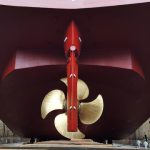As the propeller turns it absorbs the torque developed by the engine at given revolutions i.e., the delivered horsepower – and converts that to the thrust which, in turn, pushes the vessel through the water. According to Bernoulli’s law the passage of a hydrofoil (propeller blade section) through the water causes a positive pressure on the face of the blade and a negative pressure on its back. It is the resolution of the pressures that results in the torque requirement and the thrust development of the propeller. The negative pressure causes any gas in solution in the water to evolve into bubbles similar to those found when opening a bottle of lemonade or champagne. These bubbles collapse and can cause hammer like impact loads on the blades often in excess of 7 kg/cm2. It is the collapse of these bubbles that results in the observed damage to the propeller blade surfaces.
The ratio of the absorbed power or the delivered thrust to the total blade area of the propeller is called, respectively, the power and the thrust loading. If either of these exceeds a certain value which depends upon a complex relationship between the propeller type, the flow in which it works and its mean depth below the water relative to its diameter then the flow pattern of the water over the propeller blades breaks down causing a severe loss of thrust and, eventually, physical damage to the surface of the propeller blades and, also, the rudder and local steelwork of the vessel’s hull. That flow breakdown is called cavitation and is strictly analogous to the water hammer often heard in old plumbing systems. Cavitation is a highly complex phenomenon and the pitting damage it causes usually – but not necessarily – appears on the back of the blade following a clear radial pattern. It can also appear as similar damage on the driving face of the propeller in which case, almost certainly, a further factor has entered the problem in the form of an incorrect pitch distribution along the length of the blade. Most small craft propellers are usually of constant pitch over the blade length and that regime is accurate enough for 99% of boats but on high speed boats with large propeller loading factors the pitch should vary over the length of the blade i.e., the boat should be fitted with a varying pitch propeller. The effects of cavitation including loss of speed and damage to the propeller blades can be minimised by ensuring that the propeller has sufficient blade area relative to the area of the circle described by the propeller blade tips.
It is often said that cavitation is analogous to boiling with the former taking place at constant ambient temperature and the latter usually at constant ambient pressure. While the destructive potential of collapsing vapour bubbles is usually the main interest to the small craft marine surveyor, he should also keep in mind that there are also important issues of noise and vibration due to the radiating pressures involved to be considered and taken into account. The phenomena experienced in cavitation attack are usually found to be a function of the type of cavitation met, its proximity to the water surface and the rate of change of the cavity’s volume. The marine surveyor should also be aware that when the water cavities violently collapse, the local temperature in the vicinity of the cavity may also change. Experimentally it has been found that with mild steel temperatures near the cavity have locally risen to as high as 400°C when the specimen has been deeply submerged in water with a constant ambient temperature of only 25°C. Careful examination of the metal surface in way of severe cavitation damage may also reveal shades of colour due to the metal being tempered. Different metals have different resistances to attack from cavitation.

Figure 1 shows the various types of propeller cavitation
When a vessel suffers propeller cavitation the material’s surface is subjected to a continuous bombardment of impacts from a fluctuating pressure field. The propeller’s material is ductile at normal sea water temperature and, usually, the first sign of a problem is the so-called orange peel effect where the surface suffers ductile deformation leaving it looking like the surface of the familiar fruit. After that preliminary stage and depending upon the severity of the attack, damage may either cease or continue. Micro-hardness testing of both damaged and undamaged blades shows that, under conditions of cavitation attack, the material in the layers immediately below the surface work hardens and, therefore, becomes brittle. The tests show that, for undamaged blades, there is a relatively minor alteration in hardness just below the surface probably due to the manufacturing and finishing processes. On the blade surfaces that have suffered cavitation damage, however, a rapid change in hardness can be measured in the two millimetres or so closest to the area of cavitation attack. The marine surveyor should, therefore, expect that the material will fail under cavitation attack and that the failure will contain a strong element of brittleness. Experiments also show that a major influence on the rate of erosion and damage growth is the local electro-potential of the material.
There are different patterns of propeller cavitation that can occur on a marine propeller as illustrated in Figure 1 and these are usually grouped as:
• tip vortex cavitation
• sheet cavitation
• cloud cavitation
• bubble cavitation
• root cavitation
• face cavitation
• boss vortex cavitation
Some of these forms are relatively benign but others can be very aggressive in their effect on the propeller’s material.
Tip vortex propeller cavitation is due to low pressure within the vortices shed at the blade tips. Boss or hub vortex cavitation is usually due to a high angle of incidence between the direction of flow of the water and the blade leading edge in way. It can result in the outer edge of the blade looking a bit moth eaten. That form of cavitation is usually the first to show and is strongly influenced by, inter alia, the radial distribution of the propeller’s loading, the nature and variation of the vessel’s effective wake field in which the propeller operates and the local design of the blade tip. The latter is particularly true of propellers operating in Kort nozzles. When the propeller has a high or sometimes even a moderate degree of skew, vortices can also appear on the outer regions of the blades leading edge which can interact often quite aggressively with the ordinary tip vortex. The vortices can often collapse on the leading edge of the rudder or rudder horn causing severe erosion and pitting damage there. The author remembers one case where, after a short time in service, a line of deep pitting appeared on all four blades of the starboard propeller of a twin screw vessel while the port propeller was left undamaged. The damage was eventually traced to a vortex running off a padeye that had inadvertently been left welded to the shell.
Blade sheet cavitation occurs when large suction pressures build up near the leading edge of the blade resulting in the back of the blade being covered with a sheet of bubbles and is largely a function of the angle of attack of the propeller blade sections to the varying wake field encountered as the propeller rotates. The greatest pressure reductions occur on the back of the blade and this is where most sheet and bubble cavitation takes place and high tip speeds increase the possibility of such cavitation. If the sheet is relatively stable then damage to the blades is less likely than if the sheet demonstrates any form of instability.
Cloud cavitation is frequently found close to the collapse area of sheet cavitation and is extremely aggressive due to the damaging effects of the collapse of large numbers of bubbles and should always be treated with caution and, where possible, eliminated.
Bubble cavitation usually occurs at mid chord and is usually associated with too high a curvature or camber of the blade sections. It can be eliminated, if its presence can be suspected, in the design stage.

Figure 2 shows a typical pressure regime around a marine propeller blade section
Root cavitation may appear at different times in the propeller’s rotation if the circulation round the root is sufficiently strong and can be sufficiently aggressive to cause erosion damage to the boss. When the root vortices have passed down stream beyond the propeller they unite into the boss vortex and often appear in the form of a stranded rope with the number of strands equal to the number of blades. If, as is usual on single screw vessels, the rudder lies immediately abaft the propeller the rope of bubbles can collapse causing severe damage to the leading edge of the rudder or rudder post.
Face propeller cavitation occurs on the driving face of the propeller and is often due to an incorrect pitch distribution along the length of the blade resulting in the tip pitch being too small and the blade sections developing a negative angle of attack. Its results are frequently found on controllable pitch units. On one cast iron propeller of the author’s knowledge such face cavitation resulted in a hole right through each of the four blades through which it was possible to pass a man’s hand to shake hands with another man on the other side of the propeller. In the past this form of cavitation was usually considered to be very dangerous but recent research suggests that that is not necessarily so. Nevertheless, where possible, it should either be avoided or relieved by suitable design.
An associated phenomenon is called propeller-hull cavitation and sometime occurs at slow speed high load conditions such as when the vessel is accelerating from a dead slow condition. It is due to the fact that, under such conditions, the propeller sometime cannot draw enough water from ahead to satisfy its flow need and, instead pulls it in from astern. The region most affected is ahead of the propeller under the stern frame arch and the phenomenon may result in small areas of erosion and pitting on the hull. The collapse of the bubbles in the blade tip and root vortices can often lead to cavitation damage in the form of pitting on the leading edge of the rudder. When on trials, if the propeller is cavitating badly the resulting noise sounds like gravel being forcibly thrown against the underside of the hull.



Comments are closed